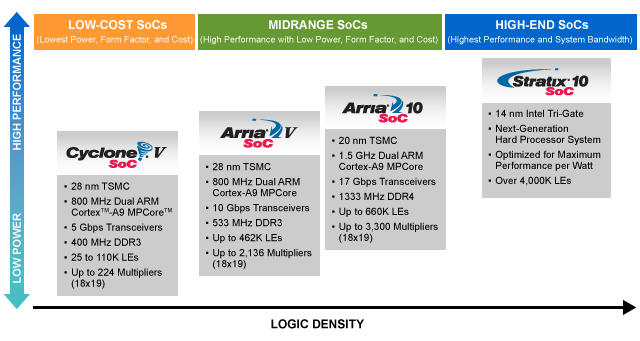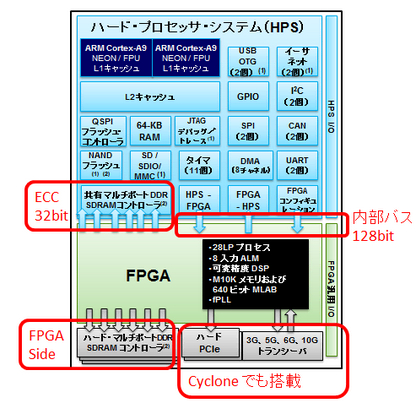Overview of Altera SoCs for Embedded Systems

Altera's new product "Altera SoC" is a hard processor system (HPS) consisting of a dual-core ARM® Cortex™-A9 MPCore™ processor, a memory controller, and a rich set of peripherals, and a 28nm FPGA fabric (Cyclone® V and Arria® V). A high-bandwidth interconnect is used to connect between the processor system and the FPGA.
ARM-based SoCs are user-customizable and combine the performance and low power consumption of hard IP with the flexibility of programmable logic and the benefits of the powerful software ecosystem of the ARM architecture.
Altera SoC Features
The system architecture of the Altera SoC provided by Altera is as follows and has various features.

|
|
|
|
|
|
5 Reasons to Design with Altera SoCs
Reduced board size
Minimize board size and complexity by reducing the number of devices on the board by integrating FPGA, microprocessor, and DSP functions on a single chip
Reduced power consumption
Altera SoC allows you to take advantage of Altera's optimized 28nm Low-Power (28LP) process technology, rich hard IP and low-power serial transceivers
Reduce total system cost
必要なディスクリート・デバイス、電源レール、およびオシレータの数が少なくてすむため、部品 (BOM) コストの削減を実現
Design with FPGA flexibility
Quickly build a custom ARM processor system by choosing the best IP cores. In addition, flexible FPGA fabric supports changing industry standards and market demands. In addition, you can quickly develop custom hardware designs using the Quartus® II development software and Qsys system integration tools
Common development tools
Leverage ARM's strong ecosystem of software development tools, operating systems and middleware
Further Expanding 28nm FPGA Portfolio
Altera offers a complete 28nm device portfolio to suit your diverse design requirements.
SoC FPGAs expands on the extensive Cyclone V SoC FPGA and Arria V SoC FPGA families. Each device family is differentiated by part number by optimizing requirements for performance, I/O resources, package size, power consumption and cost.
Start software development today
With the Altera SoC FPGA Virtual Target (Virtual Target), a fast functional simulation of SoC hard processor systems and board-level components, you can start developing application software for your SoC today. SoC Virtual Target provides unparalleled control and visibility into software, enabling greater debugging capabilities for complex multi-core processor-based embedded systems.
